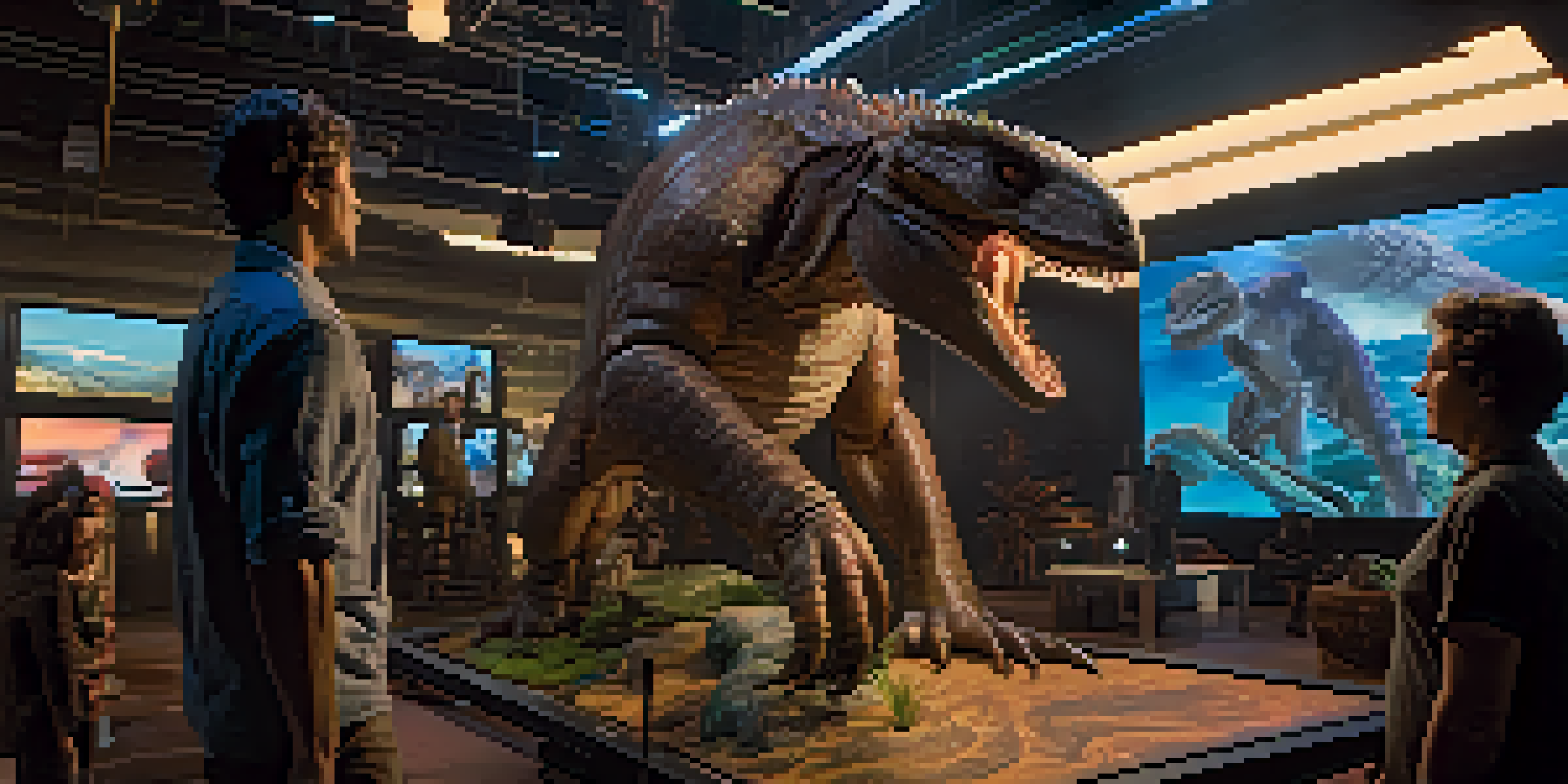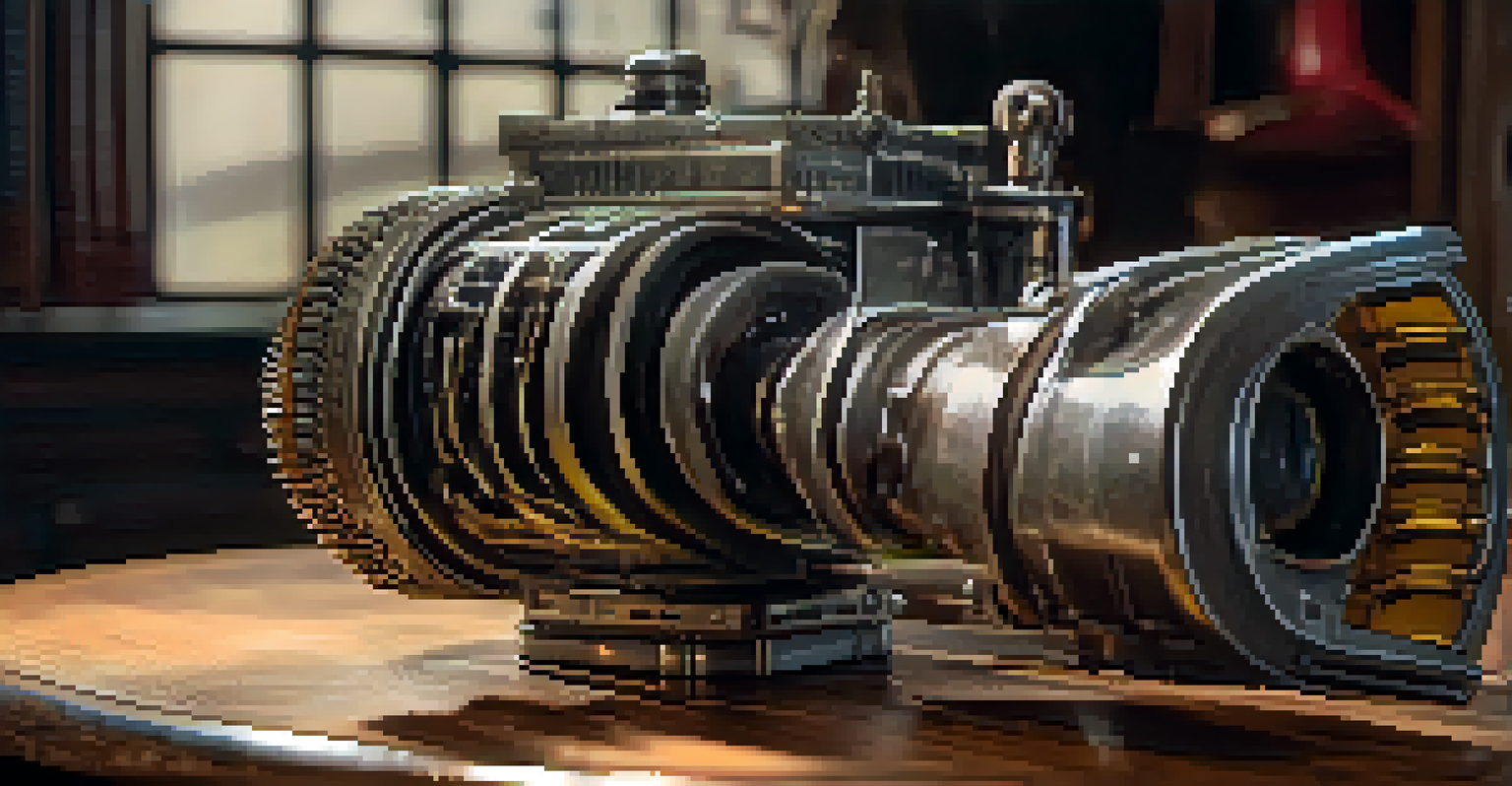Practical Effects vs. Digital: A Comparison in Film History

Understanding Practical Effects in Film
Practical effects refer to real, tangible effects created on set during filming. These can include everything from animatronics to pyrotechnics and even makeup effects. Filmmakers often favor practical effects for their authentic look and feel, which can immerse the audience in the story. Think of classics like 'Star Wars' or 'Jaws'—these films relied heavily on practical effects to create memorable moments that still resonate today.
Practical effects are the lifeblood of cinema, bringing a palpable energy that CGI often struggles to replicate.
One of the biggest advantages of practical effects is their ability to engage actors and crew in a shared reality. When an actor interacts with a physical prop or creature, the performance tends to feel more genuine and impactful. This connection often translates to a more believable experience for the audience, enhancing emotional engagement.
However, practical effects can be costly and time-consuming to produce. Creating elaborate sets or intricate models requires skilled artisans and a significant budget. This often leads filmmakers to balance their vision with practical constraints, sometimes opting for simpler effects to keep production on schedule and within budget.
The Rise of Digital Effects in Cinema
Digital effects, commonly known as CGI (Computer-Generated Imagery), revolutionized the film industry, especially in the late 20th century. With CGI, filmmakers can create stunning visuals that are often impossible to achieve with practical effects alone. From the breathtaking landscapes in 'Avatar' to the dynamic action sequences in 'The Avengers,' digital effects open up endless possibilities for storytelling.

One of the primary benefits of digital effects is the flexibility they offer. Filmmakers can easily modify scenes in post-production, allowing for creativity that may not have been possible during filming. This adaptability can save time and money, as it allows for adjustments without the need to reshoot complex scenes.
Practical Effects Enhance Authenticity
Practical effects engage actors and create a more believable experience for audiences.
However, the reliance on CGI has sparked debates among cinephiles regarding its impact on storytelling. Some argue that excessive use of digital effects can lead to a disconnect between the audience and the narrative. The challenge for filmmakers lies in finding a perfect balance, using CGI to enhance rather than overshadow the story.
The Blending of Practical and Digital Effects
In recent years, a trend has emerged where filmmakers blend both practical and digital effects to create a more immersive experience. This hybrid approach allows creators to leverage the strengths of each method while minimizing their weaknesses. For instance, using practical effects for stunts and CGI for enhancements can create a seamless visual experience that feels both real and spectacular.
Digital effects have opened new doors in storytelling, allowing filmmakers to create worlds that were previously unimaginable.
A great example of this technique can be seen in films like 'Mad Max: Fury Road,' where practical stunts were complemented by digital enhancements. This combination not only brought authenticity to the action but also captivated audiences with visually stunning sequences that felt grounded in reality. The result is a film that resonates with both nostalgic fans of practical effects and newer audiences accustomed to CGI.
The blending of these methods also reflects a broader trend in filmmaking where innovation is celebrated. As technology advances, filmmakers are continuously exploring new ways to tell stories, ensuring that both practical and digital effects have a place in cinema's future.
Iconic Examples of Practical Effects
Throughout film history, several movies have showcased the power of practical effects in unforgettable ways. 'The Thing' (1982), directed by John Carpenter, is often hailed for its groundbreaking creature effects created by Rob Bottin, which remain iconic to this day. The film's practical effects were so effective that they still evoke fear and amazement, proving that sometimes, less is more.
Another classic example is 'Terminator 2: Judgment Day,' where practical effects were combined with groundbreaking animatronics. The T-800 model, portrayed by Arnold Schwarzenegger, featured impressive physical effects that brought the character to life in a way that CGI struggled to replicate at the time. Such films demonstrate the lasting impact practical effects can have on audiences, creating memorable characters and moments.
CGI Offers Creative Flexibility
Digital effects provide filmmakers with the ability to modify scenes and enhance storytelling without reshoots.
These examples underscore the importance of practical effects in shaping cinematic history. They remind us that the tactile nature of physical effects can elicit genuine emotional responses, making them an essential part of filmmaking that should never be overlooked.
Notable Digital Effects Milestones
The evolution of digital effects has brought about several milestones that have transformed the film industry. One such landmark was the release of 'Jurassic Park' in 1993, which showcased groundbreaking CGI dinosaurs that captivated audiences worldwide. The film set a new standard for visual effects, showing that seamless integration of digital elements could create a sense of realism previously thought impossible.
Following in its footsteps, films like 'The Lord of the Rings' trilogy pushed the boundaries of digital effects even further. The creation of Gollum, a fully realized digital character, demonstrated the potential of CGI not just for visual flair but for character development as well. These advancements paved the way for future filmmakers to explore more complex narratives and characters through digital means.
As technology continues to advance, the possibilities for digital effects seem limitless. Innovations in motion capture and rendering techniques allow filmmakers to create rich, immersive worlds, giving audiences experiences that feel both familiar and otherworldly.
The Audience's Perception of Effects
The way audiences perceive practical and digital effects can vary significantly. Many viewers tend to favor practical effects for their authenticity and the tangible nature they bring to a film. This preference often stems from nostalgia for classic films that relied on these methods, creating a sense of comfort and familiarity.
Conversely, younger audiences, who have grown up with CGI-laden blockbusters, may find digital effects more appealing. They often appreciate the visual spectacle and the imaginative possibilities that digital effects can offer. This generational divide highlights the evolving landscape of filmmaking and how it influences viewer expectations.
Blending Techniques for Impact
The hybrid approach of combining practical and digital effects creates immersive experiences that appeal to diverse audiences.
Ultimately, the perception of effects is subjective, and what resonates with one viewer may not with another. This diversity in taste is what makes cinema a rich and vibrant art form, allowing for endless exploration of storytelling techniques.
The Future of Practical and Digital Effects
As the film industry continues to evolve, the future of practical and digital effects holds exciting possibilities. With advancements in technology, such as virtual reality and augmented reality, filmmakers are exploring new ways to merge both techniques. This evolution could lead to an even more immersive experience for audiences, where the lines between reality and digital art blur.
Moreover, there is a growing trend among filmmakers to return to practical effects, inspired by their nostalgic charm and authenticity. Movies like 'A Quiet Place' and 'The Batman' have demonstrated that practical effects still hold significant weight in contemporary storytelling. This resurgence suggests a potential renaissance for practical effects in an age dominated by digital technology.

The future of filmmaking will likely see a continued interplay between practical and digital effects, as both methods serve unique purposes. By embracing the strengths of each, filmmakers can create captivating stories that resonate with audiences across generations, ensuring that cinema remains a vibrant and evolving form of art.